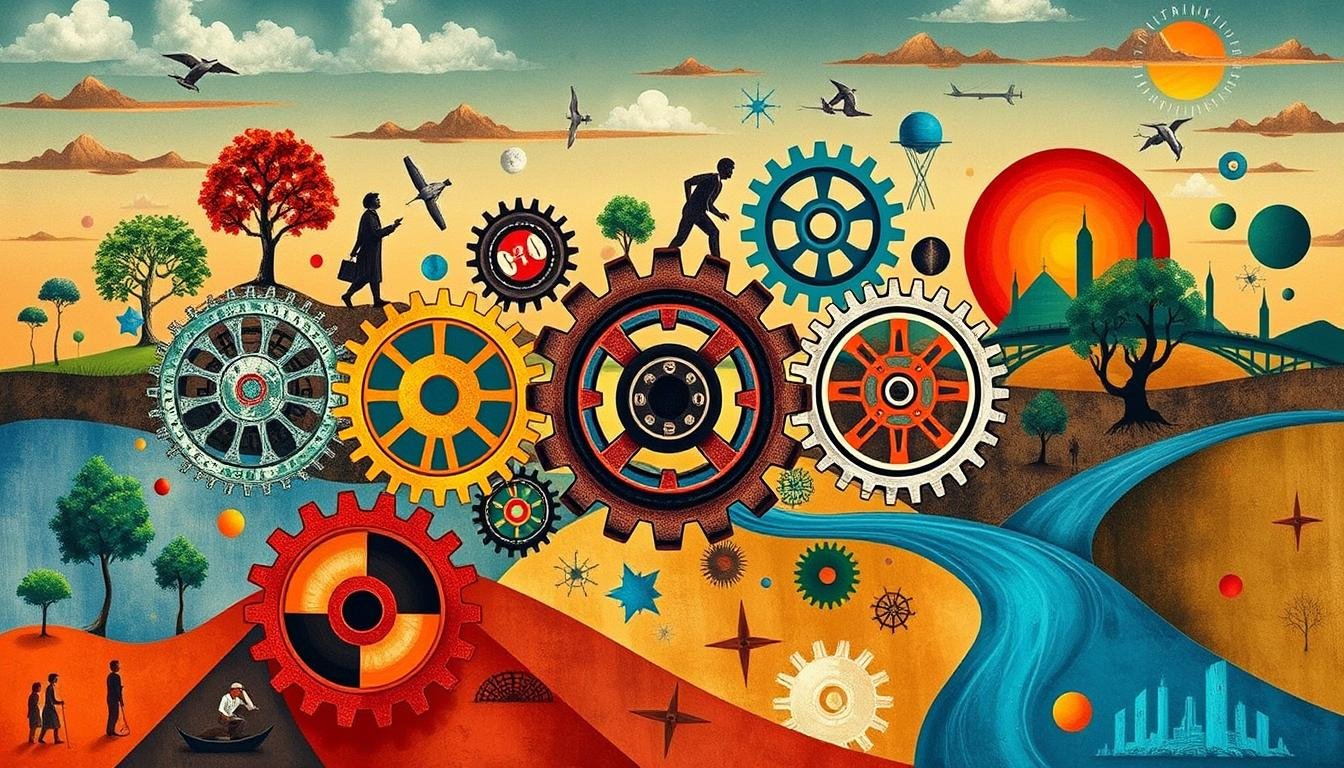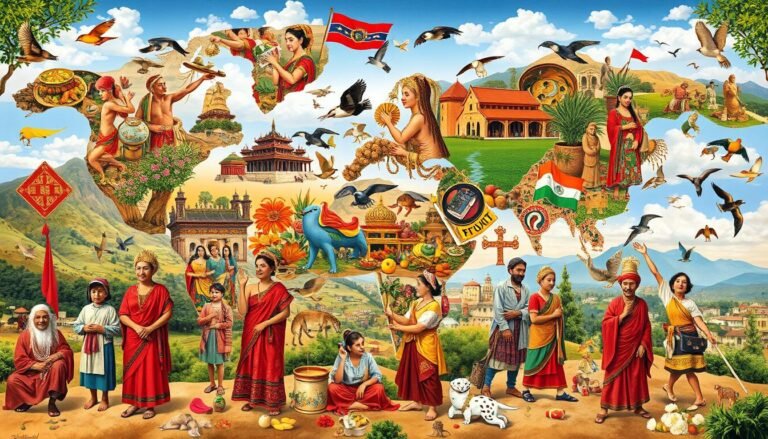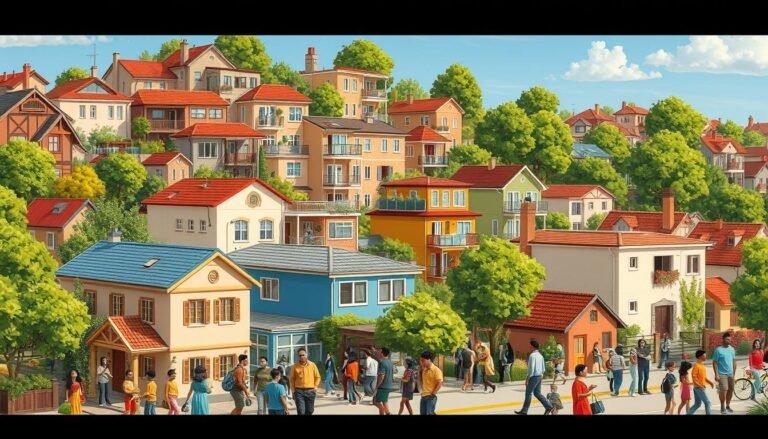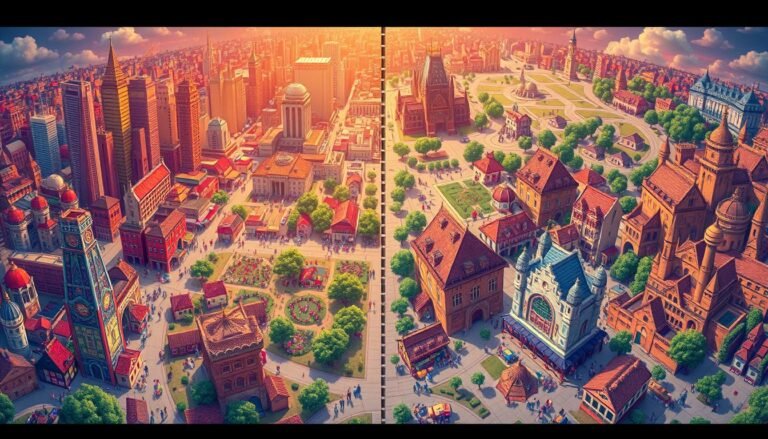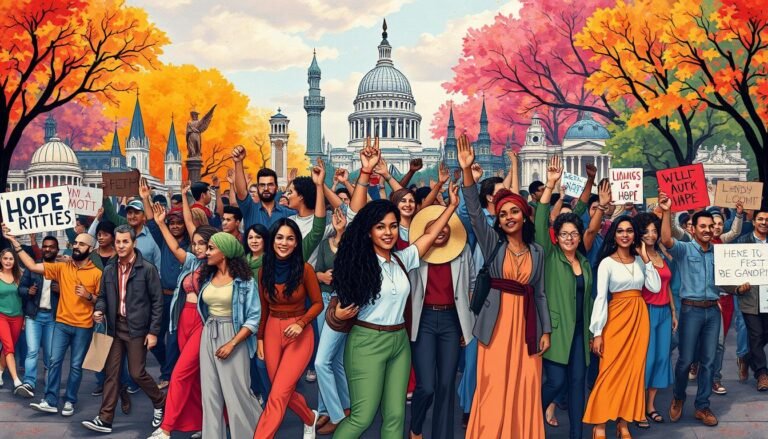Theories of Social Change: How Societies Evolve
Ever wondered what makes societies change over time? Social change theories give us deep insights into how our world changes. They show us how cultural shifts and tech advancements shape our future.
These theories look at the many factors that lead to cultural change. They help us see how societies grow, change, or even step back. By looking at history and current trends, we learn about how societies evolve.
Social change is complex and touches many areas. It includes changes in culture, economy, and politics. For example, fast city growth has changed social life and relationships. Migration has also changed cultures worldwide.
New tech has been a big force in changing societies. It has changed how we talk, work, and live. This digital change has sped up social change all over the world.
Key Takeaways
- Social change theories explain how societies evolve over time
- Cultural transformation is influenced by various factors
- Urbanization and migration significantly impact social structures
- Technological advancements drive rapid societal evolution
- Economic indicators reflect the pace of social change
- Education plays a crucial role in driving societal progress
- Long-term trends shape the trajectory of social evolution
Understanding Social Change: A Brief Overview
Social change is how societies grow and change over time. It’s a complex process that touches cultures, institutions, and how people interact. Let’s look at the main parts of social change and why it’s important.
Definition of Social Change
Social change means big shifts in social structures and cultural patterns. These changes can be slow or fast, affecting many parts of society. There are two main types:
- Changes within the existing social structure
- Changes that modify the entire social structure
Importance of Studying Social Evolution
Learning about social evolution helps us see how societies grow and change. It shows us the benefits of:
- Improved living standards
- Equitable resource distribution
- Educational opportunities
For example, women used to be kept out of universities. Now, everyone can go to school, even online for free at places like University of the People.
Key Factors Influencing Societal Transformation
Many things push for social reform and shape society:
| Factor | Impact on Social Change |
|---|---|
| Natural Environment | Influences adaptation and resource use |
| Demographic Processes | Affects population dynamics and social structures |
| Technological Innovations | Transforms communication and production methods |
| Economic Processes | Shapes wealth distribution and work patterns |
| Social Movements | Drives collective action for specific causes |
These factors work together to create complex patterns of social change. By looking at these dynamics, we can better understand and navigate the changing world around us.
Historical Perspectives on Social Change
The study of social change has deep roots in evolutionary sociology. Thinkers throughout history have tried to understand how societies change over time. They looked at three main ideas: decline, cyclic change, and continuous progress.
During the Enlightenment, the idea of social progress became popular. Figures like Anne-Robert-Jacques Turgot and Adam Smith talked about how human knowledge and technology advance. Their ideas changed how we see society’s evolution in the West.
Social change theories say that societies get more complex as they evolve. This idea fits with the concept of social progress. It suggests that societies naturally move towards better organization and development.
“Social change is the natural evolution of human interactions and relationships, leading to the transformation of cultural and social institutions.”
What drives social change includes:
- Conflict between groups
- Changes in population
- Cultural shifts
- New technology
These factors affect how societies evolve. They change everything from education to business. As societies grow and become more diverse, they often offer more freedom and accept different beliefs.
Theories of Social Change: How Societies Evolve
Social change theories explain how societies change over time. They give us insights into the complex processes that shape our world. Let’s look at three main views: evolutionary sociology, functionalist theory, and conflict theory.
Evolutionary Theory
Evolutionary sociology compares social growth to biological evolution. It says societies move from simple to complex forms. Auguste Comte proposed a linear model of social evolution, with three stages:
- Theological stage
- Metaphysical stage
- Scientific/Positive stage
Herbert Spencer built on this idea, grouping societies by their level of evolution:
| Society Type | Description |
|---|---|
| Simple | Small, egalitarian groups |
| Compound | Larger societies with basic social hierarchies |
| Doubly Compound | Complex societies with specialized institutions |
| Trebly Compound | Highly advanced, industrialized nations |
Functionalist Theory
Functionalism sees society as a system of parts working together. Talcott Parsons focused on cultural patterns that keep society stable. He believed change came from outside forces or internal adjustments.
- External influences from other societies
- Internal adjustments within the system
Conflict Theory
Conflict theory, led by Karl Marx, says society is naturally unequal. Marx looked at economic factors in social change. He said changes in production affect beliefs and culture. He pointed out two main factors:
- Production force
- Relations of production
These theories help us understand how modernization and other social change theories have developed. Each view gives us insights into how our societies change.
The Evolutionary Model of Social Change
In the late 19th century, the evolutionary model of social change became popular. It was inspired by biological evolution theories. This view of society’s growth became key in understanding how societies change over time.
Auguste Comte’s Law of Three Stages
Auguste Comte, a leading figure in sociology, introduced the “law of three stages” to describe society’s progress. He believed societies go through three main phases:
- Theological Stage: Societies explain things with supernatural beliefs
- Metaphysical Stage: Abstract forces take over from gods
- Positivist Stage: Science and observation become the main ways to understand the world
Herbert Spencer’s Social Darwinism
Herbert Spencer used evolution to explain social growth, coming up with “survival of the fittest.” He thought societies grow from simple to complex, like living organisms. Spencer believed that social progress was natural and unstoppable.
Criticisms of Evolutionary Theory
Despite its impact, evolutionary theory faced many criticisms:
- Linear Progress: The idea that all societies develop in the same way
- Western Bias: Seeing Western societies as the highest form of evolution
- Oversimplification: Missing the complexity and variety in social change
- Determinism: Underestimating how people can change social outcomes
These criticisms led to a deeper understanding of how societies evolve. They showed that social change is complex and varied. This changed how we see the evolution of societies over time.
| Theorist | Key Concept | Contribution to Social Change Theories |
|---|---|---|
| Auguste Comte | Law of Three Stages | Introduced a progressive model of societal development |
| Herbert Spencer | Social Darwinism | Applied evolutionary principles to social progress |
| Lewis Henry Morgan | Societal Classification | Categorized societies based on technological advancement |
Functionalism and Social Change
Functionalism sees society as a complex system with parts that work together for stability. Emile Durkheim started this idea, comparing society to a living thing. Each social group is like an organ in a body, crucial for the whole to function.
This view says that change is good and needed. Things like more people, new tech, and meeting other groups push society to evolve. It believes society always tries to find balance, adapting to new issues while keeping its main structure.
Some say functionalism doesn’t fully explain why some people have less than others. It also seems to ignore how fast culture changes and who has power in society. Yet, it still shapes how we think about society.
| Aspect | Functionalism | Conflict Theory |
|---|---|---|
| View of Change | Gradual and necessary | Sudden and essential |
| Focus | Stability and equilibrium | Inequality and conflict |
| Driver of Change | Internal adaptation | External pressure |
Functionalism focuses on keeping society stable. But theories like conflict theory show how tension and struggle lead to change. These different views help us understand how our social world is always changing.
Marx’s Conflict Theory and Social Evolution
Karl Marx’s conflict theory helps us see how social change happens. It says class struggle is what moves society forward. Society is divided between the rich bourgeoisie and the working-class proletariat.
Class Struggle as a Driver of Change
Marx believed class conflict drives social change. The bourgeoisie own the means of production and clash with the proletariat, who work hard. This conflict leads to big changes in society.
Historical Materialism
Marx also talked about historical materialism. He said that how we make goods affects our social, political, and intellectual lives. He believed economic factors are key to understanding how society changes.
Impact of Marxist Theory on Modern Sociology
Marxist conflict theory still shapes modern sociology. It helps us study things like inequality in schools, race, and gender. Some say it focuses too much on conflict and ignores cooperation. But, it’s still useful for looking at power and social movements.
| Aspect | Marxist Conflict Theory |
|---|---|
| Main Focus | Class struggle and economic inequality |
| View of Society | Divided into bourgeoisie and proletariat |
| Driver of Change | Conflict between social classes |
| Modern Applications | Education, race, gender studies |
Demographic Factors in Social Change
Changes in population shape our social world and culture. Growth, makeup, and spread of people change how societies adapt and face new issues. These shifts can deeply change social setups, rules, and cultural values.
Birth rates, life spans, and where people move to are big factors in these changes. Countries in sub-Saharan Africa will likely see their populations triple by 2100. On the other hand, places like China and much of Europe might see their populations drop by about 20%.
The demographic transition theory explains these changes. It groups countries by their birth and death rates:
- Stage 1: High birth and death rates, short life expectancy
- Stage 2: Higher birth rates, lower death rates, increased life expectancy
- Stage 3: Declining birth rates, increasing life expectancy
- Stage 4: Low birth and death rates, population stability or decline
These changes can affect society in many ways. For instance, fast population growth might cause shortages of resources, more people in cities, and harm the environment. But, it could also push for new ideas and growth in industries.
| Demographic Factor | Potential Social Impact |
|---|---|
| High birth rates | Resource strain, poverty |
| Low mortality rates | Aging population, healthcare challenges |
| Migration | Cultural diversity, urban growth |
Knowing about these changes helps us predict and handle social shifts. It aids in planning for the future by preparing policymakers and communities for what’s to come in our changing world.
Cultural Transformation and Societal Evolution
Cultural change is a big part of social progress. Societies change as they face new challenges. This change, known as sociocultural evolution, shows how cultures change over time.
Role of Technology in Cultural Change
Technology has a big impact on cultural change. The Industrial Revolution changed work, family life, and social structures a lot. Now, the internet is changing how we talk, do business, and connect with the world, making cultural change faster.
Globalization and Cultural Diffusion
Globalization is a big force in cultural change. It brings more connections between societies, spreading ideas and values. This mixing of cultures helps with social progress as different cultures learn from each other.
Shifts in Values and Belief Systems
As societies change, so do their values and beliefs. Theories like neoevolutionism and modernization look at how societies move from simple to complex forms. These changes can lead to new social norms, family changes, and new political systems, all helping with cultural change and social progress.
“Societies adapt themselves to complex social environments and undergo inevitable changes.”
Understanding how cultural change happens helps us see how social progress works. By looking at how technology, globalization, and changing values affect us, we can see how our societies are always evolving.
Social Movements as Catalysts for Change
Social movements push for change and reform. They shape our societies, fighting for progress and equality. From civil rights to environmental activism, these movements have made big changes over time.
There are four main types of social movements: alternative, redemptive, reformative, and revolutionary. Each type has its own role in changing society. A movement goes through four stages: starting, coming together, becoming established, and ending.
Recently, digital activism has grown a lot. Social media lets movements like Black Lives Matter and Me Too spread fast. The 2020 elections showed how social media helps with quick and detailed responses.
Older movements show the importance of staying active. The civil rights movement used strong connections to bring about lasting change. The Arab Spring in 2011 showed how social movements can spread across the world.
| Movement | Year Founded | Focus Area |
|---|---|---|
| NAACP | 1908 | Civil Rights |
| Occupy Wall Street | 2011 | Economic Inequality |
| PETA | 1980 | Animal Rights |
| Tea Party | 2009 | Conservative Politics |
Environmental disasters often start social movements. The 2010 BP oil spill led to new rules on offshore drilling. These events show how crises can lead to both new technology and big changes in society. Social movements keep changing our world, pushing for reform and transformation.
The Impact of Modernization on Social Evolution
Modernization theory shows how societies change over time. It looks at how things like industrialization, urbanization, and technology affect social progress. Let’s see how these forces have changed our world.
Industrialization and Societal Shifts
The Industrial Revolution brought big changes to society. It moved people from farms to cities and changed how we work. This shift changed family structures and community ties.
Kuznets found that as economies grew, income inequality first went up, then went down.
Urbanization and Social Structure
As cities got bigger, new social patterns emerged. Urban life brought together diverse groups, leading to new ideas and cultures. Putnam’s study of Italy showed how civic traditions in cities affect democracy.
Technological Advancements and Social Progress
Technology has made social change faster. The digital revolution has changed how we communicate, work, and live. Inkeles found that being exposed to modern institutions leads to individual changes across cultures.
This shows how tech drives social progress on a global scale.
| Aspect | Pre-Modernization | Post-Modernization |
|---|---|---|
| Work | Agriculture-based | Industry and service-based |
| Society | Rural, traditional | Urban, diverse |
| Technology | Basic tools | Advanced digital systems |
| Education | Limited access | Widespread, lifelong learning |
Challenges and Resistance to Social Change
Social change is a constant in human societies. It often faces big hurdles. The process of changing culture can be complex, with resistance coming from many places.
In traditional societies, old customs and beliefs can slow down progress. This resistance comes from a deep wish to keep things as they are. People fear the unknown.
Change is hard to achieve, even though it’s needed. Old power structures and the tendency to stick with what’s known can block the way. The rich and powerful might not want changes that could lower their status.
Others might worry about losing their identity or way of life. This resistance can show up in many areas, leading to conflicts between those pushing for change and those who prefer things as they are.
It’s important to understand these challenges to help social change happen smoothly. Resistance can be about protecting what people already have and value. At the same time, movements for freedom aim to break free from unfair traditions and fight for justice. Finding a balance between progress and respecting cultural heritage is key. This makes changing culture a careful and ongoing process.
Source Links
- THEORIES ON SOCIAL CHANGE – Achievers IAS Classes
- Social change – Patterns, Causes, Effects
- What is Social Change and Why Should We Care?
- What Is Social Change And Why Take It Seriously?
- Social Change and Why It Matters
- 20.1 Understanding Social Change
- 4. THEORIES OF SOCIAL CHANGE.pptx
- The Diverse Theories of Social Change: From Evolutionary to Conflict Perspectives • Sociology Institute
- Social change | Definition, Types, Theories, Causes, & Examples
- What is Social Change?
- 2.3 Classical Sociological Perspectives on Social Change
- Evolutionary vs. Functional Theories in Sociology: Premises Explored • Sociology Institute
- Toward a Psychology of Social Change: A Typology of Social Change
- Conflict Theory Definition, Founder, and Examples
- Understanding Social Conflict Theory – ADR Times
- What is Conflict Theory?
- Social change – Causes, Effects, Processes
- Demographic Theories | Introduction to Sociology
- 25 Social Change and Development
- Sociocultural evolution
- Social Evolutionism
- Types and Stages of Social Movements
- Chapter 21. Social Movements and Social Change
- No title found
- Social Change
- The Challenges of Social Evolution
- Sociological Theories of Social Change – UPSC Notes » LotusArise

